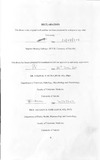| dc.description.abstract | Bovine Tuberculosis, caused by Mycobacterium bovis primarily in cattle is one of the most
important zoonotic diseases with a worldwide distribution. M bovis is the principal agent of
tuberculosis in a wide range of domestic and wild animals and has no geographical
boundaries. In Africa, the disease is poorly controlled. Frequent droughts, malnutrition, high
levels of poverty and immune-suppressing disease are common feature that favour the spread
of bovine tuberculosis in Africa. Currently, the human HIV/AIDS pandemic has made M
bovis a serious public health threat and there is increasing evidence that its infections may be
much more significant than generally considered. Bovine tuberculosis has been confirmed in
domestic animals, wildlife and humans in the countries bordering Kenya. However, it remains
a neglected zoonosis in Kenya despite the existence of uncontrolled cross-border movement
of livestock and the country having one of the highest HIV -TB burdens in Africa. This study
aimed at investigating the presence of M bovis among slaughter cattle in Kenya. The
objective of the study was to document and estimate the prevalence of bovine tuberculosis
due to M bovis using routine abattoir meat inspection procedures and microbiological
analysis. The second objective was to review and collate secondary data on bovine
tuberculosis in slaughter cattle in Kenya by examination of annual national meat inspection
reports. The study on the prevalence of M bovis was carried out from July to November 2009
at Kenya Meat Commission, (KMC), Athi River and Njiru abattoirs. The two abattoirs are
located in the outskirts of Nairobi city and slaughter cattle, sheep and goats from different
parts of the country. They supply part of the daily beef requirements to over 3.2 million
inhabitants of Nairobi. Lesioned tissue samples were randomly collected from bovine
carcases using routine abattoir inspection. Laboratory analysis was carried out at the Central
Tuberculosis Reference Laboratory (CTRL) and the Department of Veterinary Pathology,
Microbiology and Parasitology, University of Nairobi. Thirty six tissue samples were
embedded in paraffin wax, sectioned, stained with hematoxylin-eosin and evaluated
microscopically. Samples from 176 cattle were cultured for isolation of mycobacteria in
Lowenstein-Jensen (L-J) and mycobacterial growth indicator tubes (MGIT). Tissue sections,
direct sample smears and culture smears were stained by the standard Z-N staining technique
for detection of acid fast bacilli (AFB). Mycobacterial isolates were subsequently analysed by
molecular methods using GenoType® MTBC (Hain Lifescience, Nehren, Germany) DNA
strip technology. All the slaughter cattle were zebu and came from 18/47 districts covering
about 77.4% of the total land size of Kenya. A total of 929 cattle; 666 females and 263 males
were examined for tuberculous lesions. Of the carcases examined, 176 [18.95%, 95% Cl:
(16.43-21.48)] had lesions suggestive of tuberculosis which were detected in 18.32% and
20.53% females and males respectively. Statistically there was no significant difference
between prevalence of bovine tuberculosis in males and females (p>0.05). Z-N staining of
direct smears revealed 63/176 [35.80%; 95%: (28.64-42.96)] acid fast bacilli (AFB) positive
cattle giving a prevalence of 6.78% (95% CI: 5.16-8.40). Sixty four acid fast smear positive
from L-J cultures subjected to molecular analysis confirmed M bovis in 19/64 (32.8%), M
tuberculosis in 2/64 (3.1 %) and mycobacteria other than tuberculosis (MOTT) in 43/64
(67.2%). Prevalence of M bovis was found to be 2.05% [95% CI: 1.l3-2.96] by molecular
analysis. The secondary data analysis revealed that detection of bovine tuberculosis by meat
inspectors during routine abattoir meat inspection is low. This study documents for the first
time that bovine tuberculosis due to M bovis is prevalent among slaughter cattle in Kenya.
The study further revealed that bovine tuberculosis is wide spread in the arid and semi arid
(ASAL) areas of Kenya where the bulk of beef animals and over 40% of milk consumed in
Kenya come from. The presence of the human tuberculosis pathogen, M tuberculosis in the
lungs of two bovine shows the risk tuberculous patients pose to animals. The study also found
that MOTT can produce in cattle localised lesions which macroscopically and histologically
resemble lesions caused by M bovis and these findings further suggest that M bovis is not the
only Mycobacteria responsible for bovine tuberculosis. The low rate of detection of lesioned
carcases by the meat inspectors during routine abattoir meat inspection poses great health risk
to the consumers and could be a major obstacle in Kenya's international livestock trade. With
the rising incidence of TB and the ever increasing opportunistic mycobacteria-HIV coinfection
in Kenya, stringent veterinary public health particularly meat inspection procedures
should be enhanced to control zoonotic tuberculosis and other mycobacterial transmission
from food animals to humans. However, further research to determine the extent of bovine
tuberculosis in animals and humans in Kenya is needed through joint veterinary and medical
surveillance programmes. | en |

